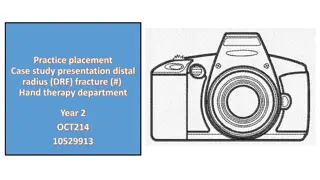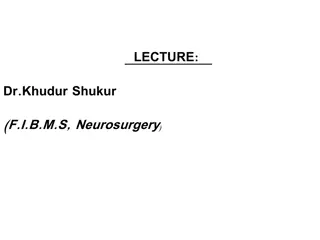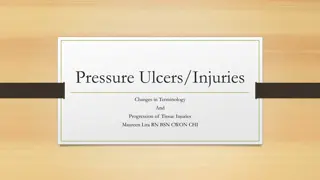Occupational Therapy and Mental Health: Supporting Clients' Return to Work
Explore the role of occupational therapists in supporting clients with mental health concerns to return to work. Understand the concept of occupational therapy, common assessments and interventions used in mental health OT, and how OTs help clients increase independent function. Discover what OTs do
1 views • 25 slides
Comprehensive Guide on Injury, Poisoning, and External Causes
This detailed guide covers various aspects of injuries, poisonings, and other consequences from external causes. It includes information on ICD10 and ICD9 coding, recording and treatment details, vocabulary related to different types of injuries, body parts classification, and code structures for di
2 views • 39 slides
Needlestick Injuries Prevention and Safety
Prevent needlestick injuries by avoiding unnecessary needle use, using devices with safety features, and implementing safe work practices. Healthcare professionals should report injuries promptly, participate in training, and get vaccinated. Be cautious when handling surgical sharps to prevent injur
5 views • 10 slides
Understanding Needle Stick Injuries and Prevention
Needle stick injuries are percutaneous piercing wounds caused by needles or other sharp instruments. They pose significant risks, including exposure to blood-borne diseases. Health-care workers are particularly vulnerable, with millions experiencing such injuries annually. Proper training, safe prac
0 views • 35 slides
Understanding Acute Knee Injuries: Meniscal Tears and Ligament Injuries
Acute knee injuries, such as meniscal tears and ligament injuries, are commonly caused by trauma or twisting motions. Meniscal tears can lead to pain, swelling, and locking of the knee joint, especially in young active individuals. Understanding the anatomy of the knee joint and meniscus, along with
0 views • 56 slides
Promoting Occupational Health in the Construction Industry
Promoting occupational health in the construction industry is crucial to prevent occupational lung diseases. Safe Work Australia reports alarming statistics of occupational illness-related deaths. The Breathe Freely Australia program emphasizes the importance of controlling exposures to prevent dise
0 views • 7 slides
Assistive Technology in Occupational Therapy: Case Review & TED Talk Analysis
Explore the intersection of occupational therapy and assistive technology through a virtual simulation module focusing on Sheena's case and a TED Talk on accessible design by occupational therapists. Delve into the benefits of adaptive equipment, reflect on its relevance in OT practice, and discover
0 views • 4 slides
Understanding Vehicle Collisions: Causes, Types, and Injuries
Vehicle collisions involve various types such as front impacts, side impacts, and rear-end collisions, resulting in different injuries like back and head injuries, neck injuries, soft tissue damage, broken bones, and internal injuries. Understanding the causes and effects of collisions can help prev
0 views • 14 slides
Understanding Occupational Therapy: A Comprehensive Overview
Occupational therapy (OT) is a crucial branch of healthcare that focuses on helping individuals of all ages with physical, sensory, or cognitive challenges to regain independence in various aspects of their lives. This summary delves into the definition of OT, its practice areas, the significance of
0 views • 14 slides
Overview of Occupational Requirements Survey (ORS) and 2020 Estimates
The Occupational Requirements Survey (ORS) by the Bureau of Labor Statistics provides detailed insights into the occupational demands of various job roles, including physical, cognitive, and environmental requirements. The survey encompasses data on speaking requirements, weight lifting capabilities
0 views • 22 slides
Comprehensive Curriculum Design for Occupational Therapy Education at the University of Tennessee Health Science Center
The curriculum design at the University of Tennessee Health Science Center's Department of Occupational Therapy emphasizes a strong foundation, including prerequisite coursework and unique life experiences. It covers a wide range of subjects, from general biology to fine arts, ensuring students are
0 views • 31 slides
OSHA Recording and Reporting Guidelines by Gayle Luker
Learn about OSHA's guidelines for recording and reporting occupational injuries and illnesses, as shared by safety consultant specialist Gayle Luker in Ohio. Understand the definitions of recordable and reportable events, the independence of OSHA injury recordkeeping and workers' compensation system
0 views • 25 slides
Overview of Burn and Scald Injuries and Classification
Burn injuries from dry heat and scald injuries from hot liquids or steam are common forms of thermal injuries. Other etiological classifications include exposure to chemicals, electrical energy, and radiation. The extent of tissue damage is directly related to temperature and duration. Classificatio
1 views • 31 slides
Occupational Therapy Management of Distal Radius Fracture in Hand Therapy Department
Occupational therapists play a crucial role in the non-surgical management of hand disorders and physical injuries, such as distal radius fractures. They focus on restoring hand function, motivating patients to exercise independently, providing holistic support, and facilitating scar management. Usi
2 views • 19 slides
First Aid Tips for Common Trauma Injuries
Learn how to manage various trauma injuries such as skull fractures, eye injuries, blowout fractures, epistaxis, mouth injuries, soft tissue injuries, open injuries, and penetrating wounds with practical first aid techniques. From treating bleeding and impaled objects to saving dislodged teeth and c
0 views • 16 slides
Preventing Road Traffic Injuries: A Global Perspective
Road traffic injuries are a significant global issue, causing millions of deaths and injuries annually. This report highlights the complexity and dangers of road traffic systems, emphasizing the need for increased awareness and preventive measures at governmental, industrial, and individual levels.
1 views • 27 slides
Complications of Fractures: Types and Risks
Complications of fractures can be classified as general, local early, and late complications. General complications include shock, embolisms, and fever while local complications involve injuries to nearby tissues and infections. Early local complications can lead to visceral, vascular, nerve injurie
0 views • 29 slides
Understanding Mechanical Injuries: Types, Classification, and General Principles
Mechanical injuries encompass a variety of harms caused to the body, mind, reputation, or property. These injuries can be classified into medical, legal, and medico-legal categories based on factors like intentionality. The types of mechanical injuries range from blunt force trauma to thermal, chemi
0 views • 79 slides
Management of Closed Head Injuries in an Austere Environment Overview
Understanding the pathophysiology of brain injuries, including intracranial pressure changes and specific injuries such as traumatic brain injury (TBI), skull fractures, brain bleeds, and diffuse axonal injuries. It covers classifications, diagnosis, and treatment approaches for mild/concussion, mod
0 views • 27 slides
Understanding Foot Pathologies: Traumatic Injuries and Pressure Injuries
Explore common foot pathologies including traumatic injuries like plantar fasciitis, turf toe, and sprains, as well as pressure injuries such as plantar ulcers and heel spurs. Learn about the causes, symptoms, and treatment options for these conditions.
0 views • 33 slides
Understanding Back Injuries and Prevention Methods
More than 1 million workers suffer from back injuries each year, accounting for a significant portion of workplace injuries. These injuries are not only painful but can also have long-term effects. It is crucial to learn how to avoid injuring or re-injuring your back to prevent pain and avoid potent
1 views • 32 slides
Understanding Pediatric Firearm Injuries and Future Research Directions
Pediatric firearm injuries are a significant public health concern, with thousands of American children affected annually. Research gaps exist in understanding the causes, consequences, and prevention strategies for pediatric firearm injuries. The lack of surveillance data and research funding hinde
0 views • 16 slides
Occupational Hygiene Approved Inspection Authorities and Exposure Data Collection
The Occupational Health and Safety Act defines an Approved Inspection Authority (AIA) as a person who, with specialized knowledge and equipment, provides services by making objective findings regarding exposure, safety, health risks, compliance with standards, etc. An AIA must be approved by the Chi
0 views • 18 slides
Occupational Health Advice in Specialty Training by Dr. Ian Aston
Occupational Health provides impartial advice on the interaction of health and work, focusing on the implications for trainee workers. It offers guidance on managing ill health-related absences and facilitating the return to work process effectively. Referral to Occupational Health results in tailor
0 views • 10 slides
RCOT Strategic Intentions and Pledge Campaign Overview
The Royal College of Occupational Therapists (RCOT) has laid out its Strategic Intentions to demonstrate leadership, raise the profile of occupational therapy, and secure the future of the profession. Through the Pledge Campaign, RCOT calls on members and stakeholders to commit to goals aligning wit
0 views • 12 slides
Understanding Injuries to the Cervical and Thoracolumbar Spine
Cervical spine injuries are common, especially in the 15-30 age group, with motor vehicle accidents, falls, and sports being major causes. Male individuals are more prone to injuries. Neurological deficits are associated with specific types of injuries, necessitating prompt imaging for spinal cord i
0 views • 20 slides
Ensuring Healthy Working Environments in Africa through Excellence in Occupational Hygiene - SAIOH President Report for SAIOH S.AGM. 2016
Synopsis of the SAIOH President's report presented at the SAIOH S.AGM. 2016 by N.W. Pieterse focuses on the current state of Occupational Hygiene in Southern Africa, challenges faced, achievements, and the way forward. It discusses the need for more occupational hygienists in South Africa and SADC c
0 views • 25 slides
Operationalising an Integrated Occupational Health Service in Indian Railways by Dr. V.K. Ramteke
Dr. V.K. Ramteke, a renowned expert in occupational health, shares his experience in operationalising an integrated occupational health service within Indian Railways. The service aims to address the specific health needs of the working population and involves various components such as curative, pr
0 views • 55 slides
Understanding Pressure Ulcers and Tissue Injuries Progression
Pressure ulcers, also known as pressure injuries, are localized damages to the skin and underlying soft tissue usually over bony prominences. The National Pressure Ulcer Advisory Panel changed the terminology in 2016 to classify all stages as injuries, not just ulcers. Stages range from non-blanchab
0 views • 13 slides
Understanding Birth Injuries in Newborns
Birth injuries in newborns can result from various factors during the birthing process, such as soft tissue injuries and head trauma. Soft tissue injuries like facial abrasions and scleral hemorrhage may occur due to causes like dystocia and forceps delivery. Nursing care involves assessing and reas
0 views • 19 slides
Understanding Upper Extremity Injuries and Shoulder Physiology
Upper extremities are prone to various injuries in sports, including sprains, strains, dislocations, fractures, and repetitive motion injuries like arthritis and tendonitis. The shoulder complex involves bones, muscles, tendons, ligaments, and articulations. Joints like the sternoclavicular, acromio
0 views • 63 slides
Understanding Common Sports Injuries by Dr. Ashish Kumar Dubey
Dr. Ashish Kumar Dubey, Assistant Professor in the Department of Physical Education, categorizes common sports injuries into soft tissue injuries, bone injuries, and joint injuries. Soft tissue injuries include sprains, strains, contusions, abrasions, lacerations, and incisions. Sprains are ligament
0 views • 7 slides
Predicting Occupational Injuries Among Denver Firefighters Using Functional Movement Screen
Functional Movement Screen (FMS) has been used to assess fundamental movements in various populations including professional athletes, firefighters, and police officers. This screening tool helps to identify injury risks and track fitness levels and recovery progress. Denver Fire Department incorpor
0 views • 21 slides
Occupational Therapy Guidelines for Adults Undergoing Total Hip Replacement
This practice guideline from the Royal College of Occupational Therapists focuses on occupational therapy intervention for adults undergoing total hip replacement. It outlines evidence-based recommendations to maximize functional independence, reduce anxiety, support role resumption, prevent readmis
0 views • 23 slides
Understanding Dentoalveolar Injuries: Causes and Classification
Dentoalveolar injuries refer to trauma affecting the teeth and their supporting structures. These injuries can range from isolated incidents to significant maxillofacial damage. They are classified into categories based on the affected tissues, including hard dental tissues, pulp, periodontal tissue
1 views • 18 slides
Evolution of Occupational and Environmental Medicine Physicians
Over the past century, Occupational and Environmental Medicine (OEM) physicians have played a crucial role in identifying and addressing occupational hazards. From the historical significance of occupational diseases to the development of specialized training programs, this field has evolved signifi
0 views • 21 slides
Understanding Occupational Diseases and Prevention Methods
This detailed training covers basic concepts of occupational diseases, types, diagnostic methods, protection measures, statistics, and legal procedures. It emphasizes the preventable nature of occupational diseases and the importance of legal responsibilities. The visuals and statistics presented hi
0 views • 49 slides
Overview of Peripheral Nerve Injuries and Brachial Plexus Injuries
Explore different types of peripheral nerve injuries including Erb's palsy, Klumpke palsy, isolated axillary nerve injury, and isolated musculocutaneous nerve injury. Learn about the anatomy, causes, motor and sensory exams, and management of these injuries. Understand the myotomes and dermatomes as
0 views • 19 slides
Enhancing Small Domain Estimation in Occupational Requirements Survey Using OEWS
This research presented at the 2021 FCSM Research & Policy Conference discusses the utilization of Occupational Employment and Wage Statistics (OEWS) to improve Small Domain Estimation (SDE) in the Occupational Requirements Survey (ORS). The study aims to produce reliable estimates at the 6-digit 20
0 views • 18 slides
Understanding Finger Injuries and Proper Assessment Guidelines
Hand injuries, especially finger injuries, are common in emergency departments. Proper diagnosis and management are crucial to prevent long-term complications. This content covers information on tendon anatomy, nerve innervation, and assessment guidelines for finger injuries.
0 views • 67 slides







































